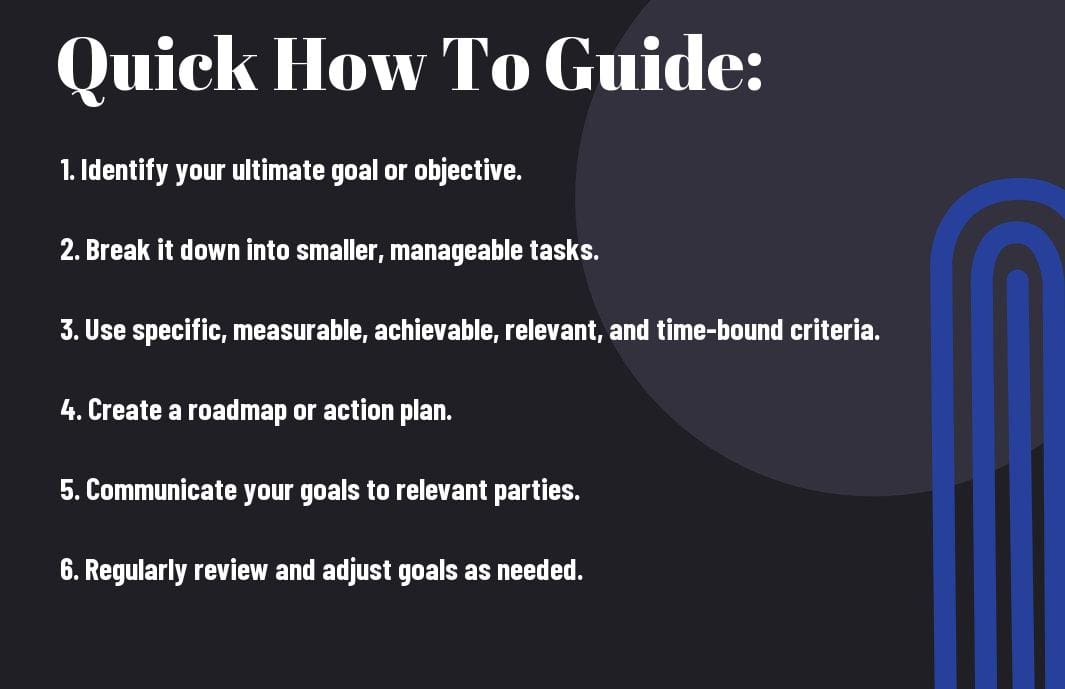Objectives #Clarity are the cornerstone of any successful endeavor, yet many individuals and businesses struggle with defining them. Achieving clarity in your goals can mean the difference between spinning your wheels and making tangible progress. In this comprehensive guide, we will walk you through the crucial steps to setting clear goals and objectives. From identifying your ultimate vision to breaking it down into actionable steps, we will provide you with practical tips and strategies to ensure that your goals are specific, measurable, attainable, relevant, and time-bound. Stay tuned to learn how to eliminate ambiguity and pave the way for success.
Key Takeaways:
- Define Purpose: Start by clearly defining the purpose of the goal or objective to provide direction and motivation.
- Be Specific: Clearly outline the desired outcomes, specific actions required, and measurable indicators of success to ensure clarity.
- Communicate Effectively: Regularly communicate the goals and objectives with team members to ensure alignment and accountability for successful implementation.

Understanding Goals and Objectives
Defining Goals vs. Objectives
Some confusion often arises around the definitions of goals and objectives. While they are closely related, there are key differences. Goals are broad, overarching outcomes that you strive to achieve, with no specific timeline or measurable criteria. On the other hand, objectives are specific, measurable steps that help you reach your goals within a set timeframe.
The Key Factors for Effective Goals
There’s no doubt that setting goals is important for success, but what are the key factors that make them effective? Clearly defined goals should be specific, measurable, achievable, relevant, and time-bound. By incorporating these elements into your goal-setting process, you increase your chances of success.
- Specific: Clearly define what you want to accomplish.
- Measurable: Establish criteria to track your progress.
- Achievable: Ensure your goals are realistic and attainable.
- Relevant: Align your goals with your overall objectives and mission.
- Time-bound: Set deadlines to create a sense of urgency.
Objectives
Factors to consider when setting objectives include being specific, measurable, attainable, relevant, and time-bound. Recognizing the difference between goals and objectives is crucial for effective goal-setting.
- Specific: Clearly outline what needs to be achieved.
- Measurable: Define how you will track progress and success.
- Attainable: Ensure that the objectives are within reach.
- Relevant: Align objectives with overall goals.
- Time-bound: Set a timeline for achieving each objective.
Tips for Setting Clear Goals
Now, when setting goals, it’s crucial to follow some key tips to ensure that your objectives are clear, achievable, and actionable. These tips will help you stay focused and motivated throughout the goal-setting process.
How-To Identify Your True Objectives
Clear identification of your true objectives is the first step in setting clear goals. Reflect on what truly matters to you, what you are passionate about, and what will bring you long-term satisfaction. Prioritize these objectives to align your goals with your values and aspirations.
Tips for Articulating Your Goals
When articulating your goals, be specific, measurable, and realistic. Break down your larger goals into smaller, manageable tasks to track progress and stay motivated. Share your goals with a trusted friend or mentor to hold yourself accountable and receive feedback for improvement.
- Be specific, measurable, and realistic
- Break down larger goals into smaller tasks
- Share goals for accountability and feedback
As you articulate your goals, pay attention to the language you use. Use positive affirmations and visualize your success to stay motivated and focused on your objectives. Perceiving your goals with clarity will help you overcome obstacles and achieve success in the long run.
Action Plans and Roadmaps
How-To Create a Step-by-Step Action Plan
If you want to achieve your goals effectively, creating a step-by-step action plan is crucial. Breaking down your goals into manageable tasks with clear deadlines will provide you with a roadmap to success. Below is a table outlining the key components of creating an action plan:
| Tasks | Deadlines |
| Define your goal | Within the next week |
| Break it down into smaller tasks | Assign deadlines to each task |
| Identify resources needed | Research and list them within two days |
Techniques for Staying on Track
With the plethora of distractions in today’s world, staying focused on your goals can be challenging. Techniques such as time blocking, setting reminders, and using productivity apps can help you stay on track. By prioritizing your tasks, creating a daily schedule, and holding yourself accountable, you can ensure that you make steady progress towards your objectives.
Create daily to-do lists and allocate specific time blocks for each task. Utilize tools like project management software to track your progress and stay organized. Additionally, regularly review your action plan and make adjustments as needed to stay aligned with your goals.

Monitoring Progress and Adjusting Goals
Despite careful planning and setting clear goals, the journey towards achieving them is not always straightforward. It’s important to monitor progress regularly and make adjustments to goals as needed to stay on track and ensure success.
How-To Measure Goal Achievement
An effective way to measure goal achievement is by setting key performance indicators (KPIs) that align with your objectives. These measurable metrics provide a quantifiable way to track progress and determine if you are moving closer towards your goals. Regularly reviewing these KPIs will give you valuable insights into what’s working and what needs adjustment.
Tips for Adjusting Goals as Needed
One key tip for adjusting goals as needed is to regularly assess the feedback and data gathered from monitoring progress. Look for any patterns or trends that indicate whether you are on the right track or if adjustments are required. It’s important to be flexible and willing to modify your goals based on new information or changing circumstances.
- Assume that…
To wrap up
The importance of setting clear goals and objectives cannot be overstated. In this guide, we have outlined the necessary steps to help you start with clarity in defining your goals and objectives. By following the simple yet effective strategies provided, you can ensure that your goals are specific, measurable, achievable, relevant, and time-bound. Bear in mind, clear goals and objectives serve as a roadmap to success, guiding your actions and decisions towards achieving your desired outcomes. Stay focused, stay disciplined, and watch as your clear goals propel you towards your ultimate success.
FAQ
Q: What is the importance of setting clear goals and objectives?
A: Setting clear goals and objectives is vital for providing direction, motivation, and a sense of purpose. It helps individuals and teams focus their efforts on what truly matters and allows for better decision-making and prioritization of tasks.
Q: How can one effectively set clear goals and objectives?
A: To set clear goals and objectives, one should follow the SMART criteria, which stands for Specific, Measurable, Achievable, Relevant, and Time-bound. This framework ensures that goals are well-defined, quantifiable, realistic, aligned with overall objectives, and have a deadline for completion.
Q: What are the benefits of using the “Start With Clarity – A How-To Guide To Setting Clear Goals And Objectives”?
A: This guide provides practical strategies and techniques for defining clear goals and objectives, breaking them down into manageable tasks, and creating an action plan for achievement. It helps individuals and teams establish a clear roadmap towards success and enhances accountability and productivity.




